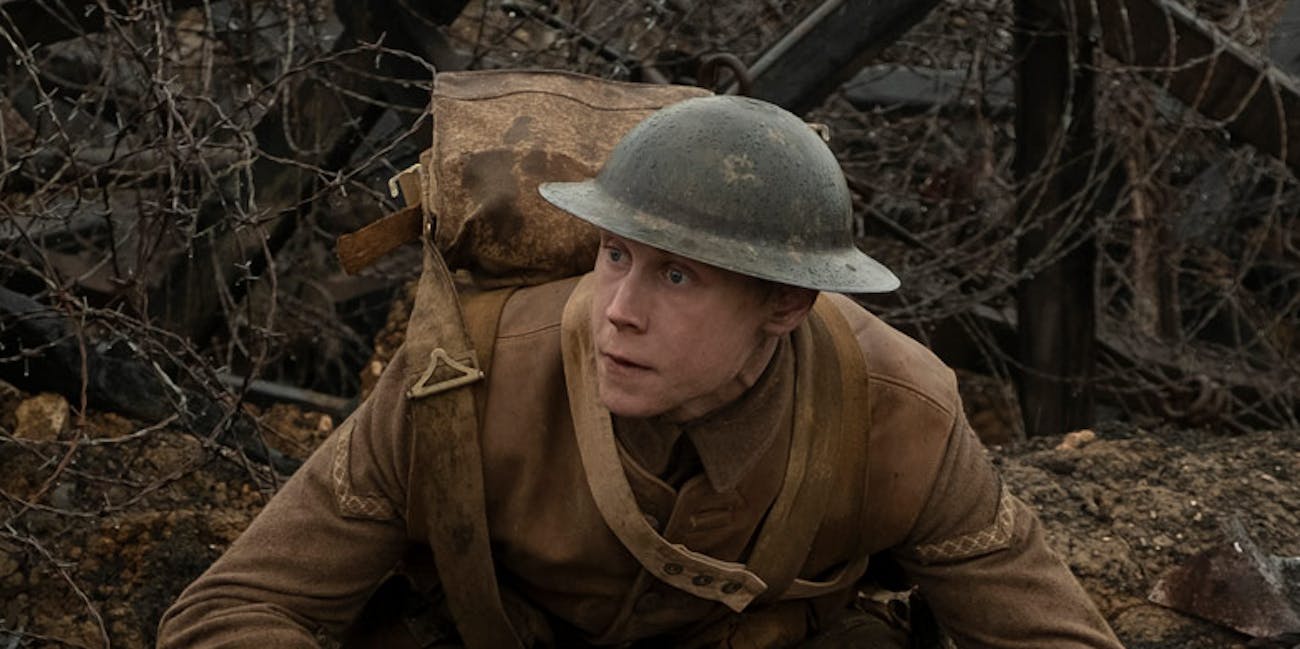1917 is a horror story. It is a journey to hell and back. It ends at the place where it began, in a field of flowers under a tree. It is a story of duty, comradeship and loss. It is a technical marvel.
It takes place on April 6, 1917, the day the United States declared war on Germany, and thereby the Central Powers. The setting is the War to End All Wars, The Great War, World War I. The destruction of the Colonial Empires and the setting of the stage for World War II.
When a movie is shot on film, the longest take can only last for a relativity short period of time. At 90 feet a minute, 16 frames to a foot, 24 frames a second, a 1000 foot reel of negative can last for ten minutes, more or less. But director Sam Mendes chose to shoot digital, allowing for a single shot to last much longer than ten minutes. In fact, it would seem the first shot of the film lasts for twenty-five minutes, until the camera enters the blackness of a tunnel, the most convenient spot for an end. However, it is a seamless narrative. The the camera never leaves the soldiers.

What editor Lee Smith was left to do is a mystery. The flow of images here was accomplished with no visible edits. (Hitchcock attempted something like it with Rope in 1948.) His background as a sound effects editor and sound designer would suggest he had much to do the superb sound effects heard in 1917, although Oliver Tarney is credited as supervising sound editor.
Mendes reasoned quite correctly this would grab the viewer’s emotions and keep us within the narrative and not let go. Two British soldiers on the Western Front are given the task of such importance, the lives of hundreds of their fellows depend on it. Corporal Blake (Dean-Charles Chapman) and Corporal Schofield (George MacKay) pass through the the British lines and into no-mans-land, and the stench and destruction of the battlefield. Dead men, dead horses and live rats populate the start of the journey. You can almost smell the corruption.
Blake has a personal interest in the mission, this journey. His brother, a lieutenant in a unit in the planned attack the next morning, may well perish in a German ambush. Schofield, however, would have just as likely remained in safety under the tree.
There is a marked contrast between the British trenches (the Western Front was a warren of trenches) and the German’s. They are dry, with masonry foundations, unlike the muddy, water soaked trenches of the British. More fortifications than glorified ditches, leading to a network of tunnels filled with evidence of crumbling German expectations.

The film puts a lie to the idea of the chivalry of the World War I fighter pilot. One of them, anyway. A German. The journey takes us to the ruins of a city in flames on Hell’s edge, populated by demons seen only in silhouette, and a hidden sign of hope for a future.
This is an epic Odyssey, made possible by assistant directors, assistant cameraman, gaffers, grips and set dressers, prop-men and other crew who have accomplished something not done before in cinema, but will receive no recognition other than the roll of end credits. Their task was greater than in other conventionally shot films.

Roger Deakins and his crew have done a remarkable job in lighting the movement through the scenes. I have no doubt he will be receive awards for it. I would be remiss it I did not mention the magnificent score by Thomas Newman, worthy of comparison to Maurice Jarre’s music in Lawrence of Arabia.
Mendes, with his collaborators and crew have created something new in cinema, a film that will engender many attempts at imitation..